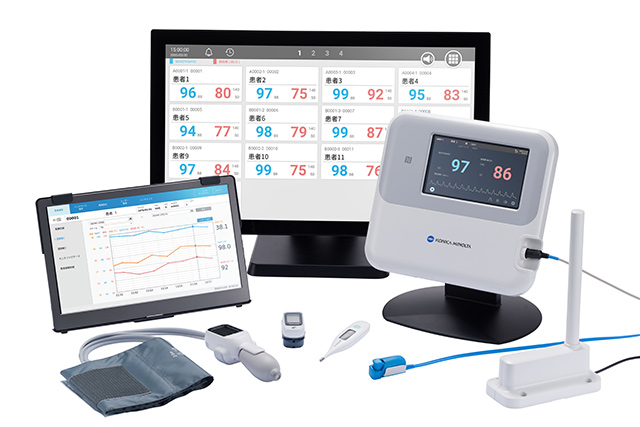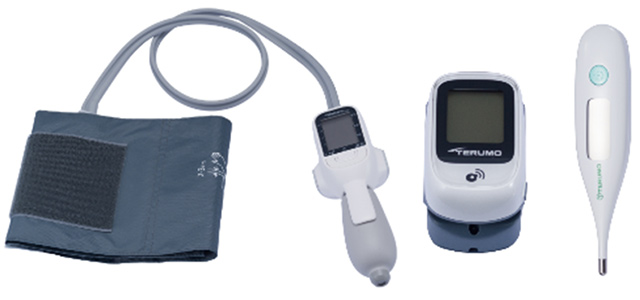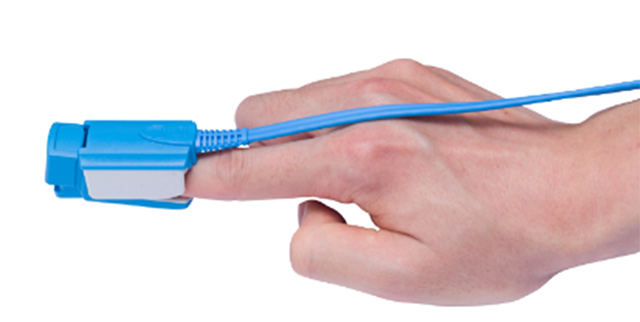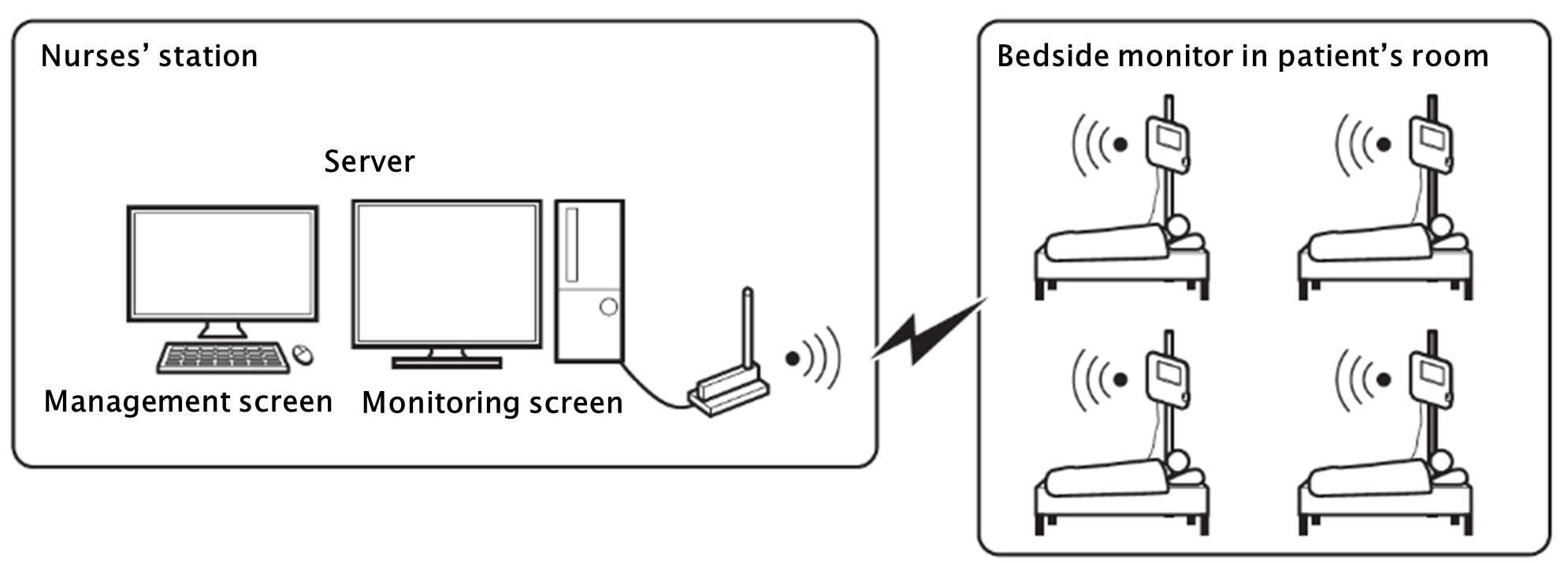News Releases
Konica Minolta to Launch a New Patient Monitoring System, VS1, Helping Hospitals for Anticipated Covid-19 Surge
To Improve Hospital Work Efficiency and Reduce the Risk of Contact With Infection Sources
December 23, 2020
Tokyo (December 23, 2020) – Konica Minolta, Inc. (Konica Minolta) announced that the company will launch VS1, a patient monitoring system, in Japan by the end of 2020 for Covid-19 hospitalized patients with mild to moderate disease who are treated in isolation zones. VS1 makes it possible to send spot check vital signs of such patients, measured by a pulse oximeter*1, a thermometer, and a blood-pressure monitor and the patients’ continuous monitoring data with pulse oximeter transmitted to the nurses’ station, located outside the isolation zone via a sub-GHz wireless network, thus enabling collective data management at the station.

Purpose of Development
The VS1 patient monitoring system automatically transmits monitoring data with bedside monitor to the nurses’ station and enables oxygen saturation (SpO2) values, which indicate the severity of Covid-19 diseases, to be monitored simultaneously on the bedside and on the monitor in the nurses’ station. VS1 also enables body temperature, blood pressure and other vital signs of patients measured at the bedside to be integrally managed at the nurses’ station as part of the nursing records. With this system, Konica Minolta aims to enhance the work efficiency and safety of healthcare workers who treat Covid-19 patients.
Outline of the VS1 Patient Monitoring System
1) VS1 bedside monitor equips near-field communications (NFC) reader. When a healthcare worker touches the bedside monitor with HR joint*2 measurement devices including pulse oximeter, thermometer, or blood-pressure monitor, VS1 automatically reads devices’ data, and sends these vital signs to the server in the nurses’ station.

2) When a patient condition becomes worse, SpO2 monitor is attached and VS1 bedside monitor sends the patient’s SpO2 continuously to the server in the nurses’ station.

3) The monitoring data and vital signs of each patient are stored in the server at the nurses’ station outside the isolated zone. These data can be used for management of patient information and keeping and updating nursing records.

4) The SpO2 and pulse rate of the patient under continuous monitoring are shown on both the bedside monitor and the server in the nurses’ station in real-time. If any unusual matter occurs, an alarm buzzer sounds.

Values of the VS1 Patient Monitoring System
1. Reducing the workload of healthcare workers in isolated contaminated zone and enhancing medical safety
When treating Covid-19 patients, healthcare workers check the body temperature, SpO2 and other vital signs of patients several times a day to observe how the patients’ conditions change over time. Vital signs check and records under infection preventive conditions are one of the burdens for nurses under Covid-19. VS1 enhances the efficiency of vital sign checks by enabling healthcare workers to instantly send the vital signs to the nurses’ station simply by touching the bedside monitor, and enter the data into the database in real-time.
This system also allows centralized and integrated management of nursing records, such as vital signs obtained from both spot-check and continuous monitoring, for the entire period from the patient’s hospitalization to discharge. Even if a patient is moved to a different room due to a disease condition change, healthcare workers in charge can keep and continue to use the patient’s data by moving the bedside monitor together with the patient or switching the registration of the patient to the new bedside monitor in the new room.
With this system, various data measured in the isolated red zone area can be seen in the nurses’ station outside safety zone area, allowing healthcare workers to remotely assess patients’ conditions and observe their changes over time without fear of infection. This reduces the workload and manpower needed in the isolated area and minimizes the risk of healthcare workers contacting infection sources and carrying out the infection, thus helping to prevent nosocomial infection and enhance medical safety.
2. Overcoming the shortage of monitoring equipment caused by increasing numbers of moderate patients
In Japan, Covid-19 patients who have developed pneumonia and respiratory condition are introduced. While existing stationary patient monitoring systems can do this, these systems should be occupied for patients with severe conditions treated in ICUs (Intensive Care Units) during the peak of infection. Conventional portable telemeter systems can also continuously monitor SpO2, but there are not enough to cover the shortage of monitoring equipment. As the number of patients suffering respiratory failure increases, there is a growing need for continuous monitoring of SpO2.
VS1 can seamlessly meet changing needs from spot-check to continuous monitoring of SpO2 as the severity of symptoms advances from mild to moderate, and vice versa, and thus overcome a shortage of monitoring equipment caused by increasing numbers of patients with moderate symptoms.
3. Eliminating the need to install an antenna in a patient’s room, enabling immediate use
VS1 is the world’s first patient monitoring system for medical use*3 to employ a sub-GHz wireless network, which has a lower risk of interfering with other wireless systems and can cover a longer distance than a wireless LAN. VS1 bedside monitor equips an antenna inside. Bedside monitors and a tabletop antenna for server PC in the nurses’ station can communicate via Sub-GHz wireless network between patients room and nurses room without antenna wiring work between both rooms.
VS1 can be quickly started up just by bringing in a bedside monitor and so can cope with a rapid increase of patients who need monitoring, without needing additional staff for antenna wiring work, setting up the communication environment and radio channel control, and setting up and adjust the necessary equipment. VS1 can be started with minimum access to the contamination area, thus helping to protect the safety of healthcare workers and reducing the risk of nosocomial infection.
The Konica Minolta Group is exploring ways to contribute in this time of crisis, and has begun to offer support services and solutions in each of its wide-ranging business fields, in hope that these services and solutions will help overcome the difficulties the world now faces.
*1: A pulse oximeter is used to measure arterial oxygen saturation (SpO2) and pulse rate by shining a light through the fingertip or other part of the body, without taking a blood sample.
*2:Only the HR Joint-compatible pulse oximeter, thermometer, and blood-pressure monitor designated by Konica Minolta can be used. HR Joint is a registered trademark of Terumo Corporation.
*3: According to Konica Minolta as of December 16, 2020.

